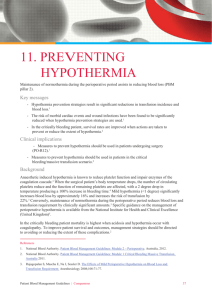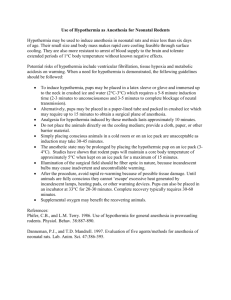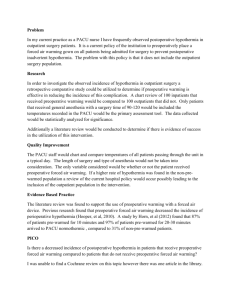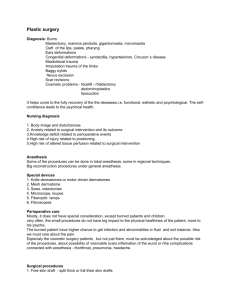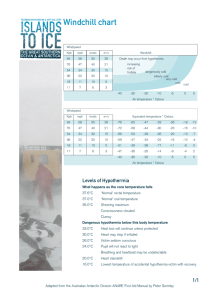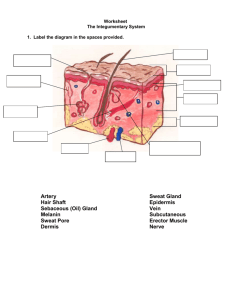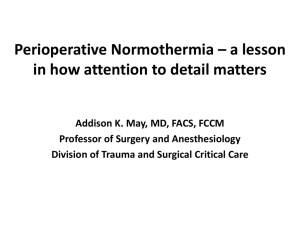Normothermia(1) - Vanderbilt University Medical Center
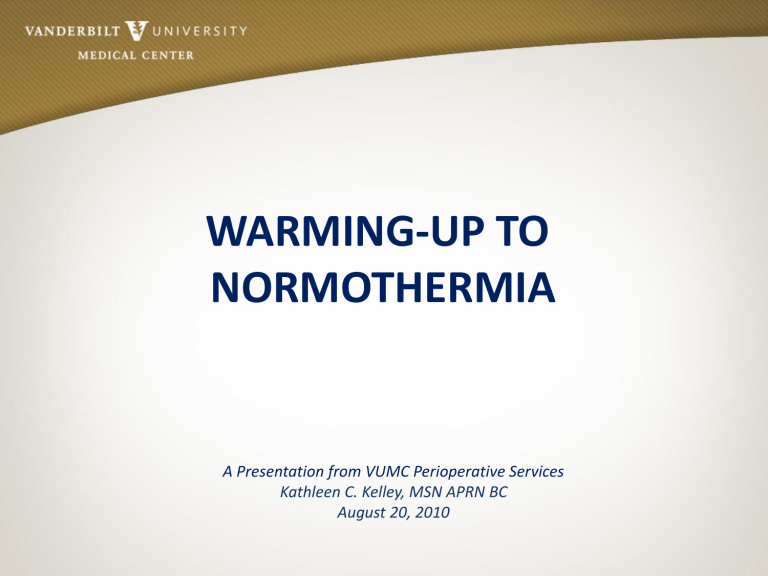
WARMING-UP TO
NORMOTHERMIA
A Presentation from VUMC Perioperative Services
Kathleen C. Kelley, MSN APRN BC
August 20, 2010
'Warming Up to Normothermia' is designed for Perioperative staff to understand and to maintain optimal surgical patient temperature
This presentation reviews definitions, physiological outcomes of hypothermia, common causes of hypothermia and perioperative expectations
Course Objectives
To know the definition of Normothermia
To know the VUMC Perioperative Goals for
Surgical Patients
To become familiar with Normothermia terminology
To identify Dangers of Hypothermia
To be able to identify common risk factors & causes of hypothermia
To identify Perioperative Expectations
To change practice- “Make Warm the Norm”
What is Normothermia?
A core temperature range of
36 ° C to 38 ° C
(98.6
° F–100.4
° F)
Medical Center
Perioperative Goals
For Surgical Patients:
To provide the patient with a consistent approach for Normothermia while in the Perioperative setting unless the procedure necessitates a hypothermic environment
Target Patient Temperature:
90% patients with first and post-op temp > 36 ° C
80% patients with minimum temp > 36 ° C
Intra op Room Temperature Goals:
OR Temperature = 24 ° C (75 ° F)
Level 1 Trauma = 29.5
° C (85 ° F)
Terminology
Core Temperature: The thermal compartment of the body composed of highly perfused tissues where the temperature is uniform and high compared to the rest of the body
Ambient Temperature: simply means "the temperature of the surroundings"
Hypothermia: core temperature less than 36 ° C anytime during the Perioperative period
Physiological effects of Mild Hypothermia
Patient Temperature is 32–35 ° C or 90–95 ° F
Shivering
Hypertension
Tachycardia
Tachypnea
Cold diuresis
Mental confusion
Hyperglycemia
Hepatic Dysfunction
Vasoconstriction Piloerection (goose bumps)
Risks Factors for Hypothermia
• Extremes in patient ages
• Induced inhibition of thermoregulation during surgical procedures
• Female sex, and physical status
• Ambient room temperatures
• Length and type of surgical procedure
• Decreased metabolic heat production/Increased environmental heat loss
• Redistribution of heat within the body • Amount of body fat (Cachexia -physical tissue wasting with loss of weight and muscle mass)
• Pre-existing conditions- (peripheral vascular disease, endocrine disease, pregnancy, burns, open wounds, etc.)
• Significant fluid shifts/Use of cold irrigates
• Use of general and regional anesthesia
WHAT ARE THE PHYSIOLOGICAL
OUTCOMES OF HYPOTHERMIA?
Research suggests that patients who are hypothermic during the Perioperative phase of their care have an increased risk of developing the following:
• Surgical site infections
• Adverse cardiac events
• Discomfort
• Longer length of stay in the hospital
• More prone to bleeding during surgery
In randomized studies, efforts to maintain Normothermia:
Reduced infectious complications by 50%
Reduced ileus, Hospital LOS for infected and uninfected patients
Reduced cardiac morbidity Reduced blood loss
Barie, PS Surgical Site Infections: Epidemiology and Prevention. Surgical Infections. Vol 3, Suppl 2002;s9-s21Jeran, L. American Society of
PeriAnesthesia Nurses Development Panel. Clinical Guidelines for the Prevention of Unplanned Perioperative Hypothermia. Journal of
PeriAnesthesia Nursing.Oct. 2001 Vol 16(5) pp305-314.
Tryba, M. Lehan, J. et al. Does active warming of severely injured trauma patients influence perioperative morbidity? Anesthesiology, 1996;85:A283.
Increased Blood Loss
Increases blood loss secondary to:
• Temperature induced coagulopathy (bleeding or clotting disorders)
• Altered and reduce platelet function
• Decreased activation of coagulation cascade
• Increased need for transfusion of red blood cells, platelets, and plasma
Barie, PS Surgical Site Infections: Epidemiology and Prevention. Surgical Infections. Vol 3, Suppl 2002;s9-s21
Jeran, L. American Society of PeriAnesthesia Nurses Development Panel. Clinical Guidelines for the Prevention of Unplanned Perioperative Hypothermia. Journal of
PeriAnesthesia Nursing.Oct. 2001 Vol 16(5) pp305-314.
Tryba, M. Lehan, J. et al. Does active warming of severely injured trauma patients influence perioperative morbidity? Anesthesiology, 1996;85:A283.
Increased Infection
Increases susceptibility to infections:
• Decreased perfusion, altered phagocytic function and decreased antibiotic penetration
• Decreased cutaneous blood flow
• Directly impaired immune function
(neutrophils less effective)
• Protein wasting and decreased collagen synthesis
Other Potential
Complications
• Increased risk for adverse cardiac events (Increases cardiac morbidity: Vasoconstriction, shivering, cardiac dysrhythmias)
• Increased oxygen consumption due to shivering (400% to 500%)
• Increased energy requirements related to the increase in oxygen consumption
• Increased need for postoperative mechanical ventilation
• Medication metabolism is reduced while duration of action is longer
Perioperative Expectations
It is not uncommon for patients to be hypothermic upon arrival to the Holding
Room or Post Anesthesia Care Unit (PACU).
Unless hypothermia is indicated (i.e. CABG) intra-operatively, the goal for the Perioperative patient is to maintain NORMOTHERMIA!
Measure patient core temperature – if < 36.6, turn on forced air warming via BAIR PAWS. If greater, can d/c forced air warming.
Increase Ambient Room Temperature-
Recommended AORN Practice Guidelines 20 ° -
24 ° C or 68 ° -75 ° F.
Hypothermia in the
Holding Room
In the Pre-Op/Holding Room, reasons for patient being hypothermia may be due to
Nurse/Patient perception
Nurses may assume that a patient knows if he or she is cold thru interview. The patient may not always be aware that they are hypothermic.
Or, the Patient maybe unable to communicate (example-trauma pt)
This is an educational opportunity for nurse to inform the patient of the benefits of Normothermia.
Pre-Operative Management
Hold your patient’s head so it does not move, or tell the person not to move his head. If you are checking an adult, gently pull the ear up and then back.
Measure the patient's temperature on admission
(Tympanic is the preferred method)
All elective cases should have Bair Paws placed on the patient in holding room and forced warm air turned on to maintain temperature greater than 36.5
° C at all times
Identify patient risk factors for hypothermia (age, weight, overall health etc)
Determine the patient's thermal comfort level
Observe for symptoms of hypothermia (Shivering, piloerection [goose bumps} and/or cold extremities)
Temperature Regulating
Device Safety
Device Safety for HR/PACU
Plastic surfaces should not come in contact with patient’s skin.
Unless temperature-regulating blankets are designed to be placed next to patient’s skin, a thin cloth covering should be placed between the device and the patient to protect the skin.
Any heat-regulating device should be used according to manufacturer’s recommendations. Skin integrity should be inspected before, periodically during (when possible), and after using devices such as ice packs and temperature-regulating blankets.
• Apply warm blankets per policy
• Adjust room temperature
• Monitor patient temperature to avoid overheating
• Use heat-maintaining devices (e.g., hats, blankets, socks)
• Administer warmed irrigation or infusion solutions
• Administer humidified oxygen and/or anesthetic gases
• Fluids should be heated or cooled in devices intended for that purpose
• Microwaves and autoclaves should not be used as warming devices
The Celsius/Fahrenheit Conversion Calculator can be found in the electronic VPIMS charting (Pre-Op, Intra-Op and Post-Op )
Intra Operative Causes Hypothermia
• In the Intra-Operative/OR areas, hypothermia may be due to :
• Low ambient temperature in the operating room
• Administration of un-warmed IV fluids
• Decreased metabolic rate during surgery
• Medication-induced vasodilation
• Exposure of body cavities to room-temperature air
• Loss of heat from lungs when un-warmed
• Inhaled gases are used
• Use of general anesthesia
Intra-Op Management
1) Room temperature to be recorded in VPIMS. Recommended ambient room temperature-20 ° -24 ° C or 68 ° -75 ° F
2) Anesthesia records temperatures during case and "30 minutes prior to or 15
minutes after anesthesia end time” in Gas Chart.
3) Room temperature may be adjusted during case as long as the patient core temp
> 36.5
° C
4) Peri-induction and intra-operative management: Bear Paws (if elective) / Bear
Hugger applied, forced air @ 40 ° C prior to induction & prep
5) Upper & lower forced air warming devices should be applied as allowed by the case
6) Intra-operative fluids and irrigation should be warmed to 37 ° C per fluid warmer
7) Should cover the lower body with Bear Hugger prior to prep to avoid air turbulence over the prep
8) Drape patient prior to turning on the upper body warmer to prevent air turbulence
9) Forced air devices should be utilized during induction of general anesthesia, held for prep of patient, but reinitiated as soon as draping is completed
10) Patient exposure should be minimized as much as possible during and after induction
Temperature Regulating Device Safety
Device Safety for Intra-OP
Plastic surfaces should not come in contact with patient’s skin.
Unless temperature-regulating blankets are designed to be placed next to patient’s skin, a thin cloth covering should be placed between the device and the patient to protect the skin.
Any heat-regulating device should be used according to manufacturer’s recommendations. Skin integrity should be inspected before, periodically during (when possible), and after using devices such as ice packs and temperature-regulating blankets.
• Apply warm blankets per policy
• Limit amount of skin surface exposed during positioning and skin preparation
• Limit amount of time between skin preparation and draping
• Prevent surgical drapes from becoming wet
• Adjust room temperature
• Monitor patient temperature to avoid overheating
• Use heat-maintaining devices (e.g., hats, blankets, socks)
• Administer warmed irrigation or infusion solutions
• Administer humidified oxygen and/or anesthetic gases
• Fluids should be heated or cooled in devices intended for that purpose
• Microwaves and autoclaves should not be used as warming devices.
Post-Operative Management
In the PACU, Hypothermia may be due to the failure to recognize warming device is not connected or the inadvertent removal of the warming device during transfer from the OR bed to the stretcher.
Post-operative management :
Patients are immediately covered with either warm blankets and/or forced air device depending on patient core temperature
Initial patient temperature is taken on ALL PACU patients
Nurses are to contact Anesthesia Provider or Attending Physician if patient core temperature is < 36 ° C
Increase ambient room temperature (minimum 24 ° C or 75 ° F)
Warm fluids: Intravenous
Humidify and warm gases on ventilator patient (38 ° C-40 ° C)
Assess temperature and patient’s thermal comfort level every 30 minutes until Normothermia is reached
Measure and record temperatures thru out PACU care and prior to discharge
Intra Operative
Recommendations for Providers
Intra-operative, ambient room temperature for Non-trauma cases should be set at 24 ° C (75 ° F)
Level 1 Trauma
29.5
° C (85 ° F)
Anesthesia records temperatures during case and "30 minutes prior to or 15 minutes after anesthesia end
time” in Gas Chart-vitals grid as shown below
The second temperature is charted under the Emergence Tab in the PACU Vital Sign section.
Where We Stand with
Hypothermia?
Minimum Temperature Hypothermia by Service
Aug
2009
Sep
2009
Oct 20
09
Nov 2
009 009
Dec 2
Date
Jan
20
10
Feb 2
01
0
Mar
2010
Orthopedic Trauma
Colorectal
EGS/Trauma
Vascular
Apr 2
010
The graph demonstrates the percentage of patients' temperatures < 36 ° C by Service
The Bottom-Line on Normothermia
Patient exposure should be minimized as much as possible during and after induction Forced air devices should be utilized during induction of general anesthesia, held for prep, but reinitiated as soon as draping is completed
Normothermia:
Reduces the negative effects experienced by the patient
Optimizes wound healing and recovery times
Prevents extended hospitalization, thereby reducing cost of care and increasing patient satisfaction
Questions?
Thank you for your time and the opportunity in sharing this information on
Normothermia!
And Remember…..Make Warm the Norm!
A Presentation from VUMC Perioperative Services
MAKE WARM THE NORM!
This is Norm
